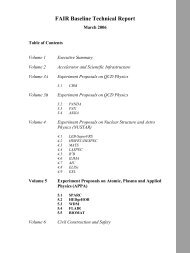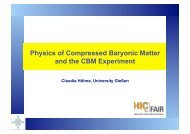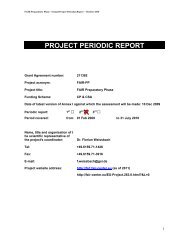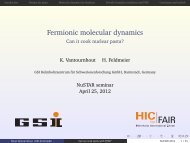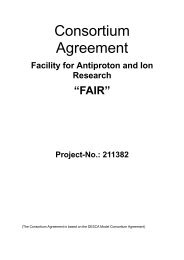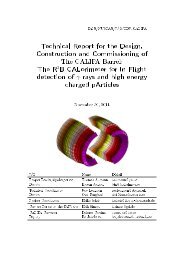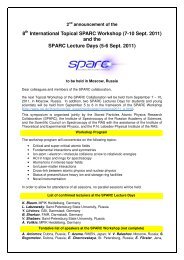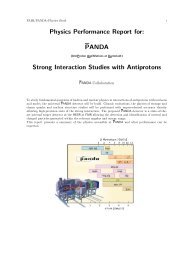NeuLAND - FAIR
NeuLAND - FAIR
NeuLAND - FAIR
Create successful ePaper yourself
Turn your PDF publications into a flip-book with our unique Google optimized e-Paper software.
findings, see figure 4.3. Overall, a very good agreement is found for the two scintillator<br />
materials, the large range of neutron energies and the various energy threshold<br />
settings.<br />
efficiency [%]<br />
40<br />
35<br />
30<br />
25<br />
20<br />
15<br />
10<br />
5<br />
0<br />
20 40 60 80 100 120<br />
neutron energy [MeV]<br />
2.8 MeV exp<br />
5.58 MeV exp<br />
7.89 MeV exp<br />
11.15 MeV exp<br />
15.75 MeV exp<br />
2.8 MeV sim<br />
5.58 MeV sim<br />
7.89 MeV sim<br />
11.15 MeV sim<br />
15.75 MeV sim<br />
efficiency [%]<br />
70<br />
60<br />
50<br />
40<br />
30<br />
20<br />
10<br />
0<br />
1 10<br />
PILOT-Y<br />
0.2 MeV exp<br />
1.0 MeV exp<br />
4.0 MeV exp<br />
0.2 MeV sim<br />
1.0 MeV sim<br />
4.0 MeV sim<br />
10<br />
neutron energy [MeV]<br />
Figure 4.3.: Neutron efficiency as a function of the energy of impinging neutron for the<br />
two plastic scintillator materials. The data (symbols) for the scintillator<br />
NE-110 are displayed on the left hand side [Bet-76] and the data for the<br />
scintillator Pilot-U on the right hand side [Ede-72]. The GEANT4 simulated<br />
neutron efficiencies are presented as solid curves. The legends detail<br />
the different threshold settings in equivalent-electron energies for the experimental<br />
and simulated data.<br />
Second, we compare the simulation to the neutron response of the existing LAND detector<br />
[Bla-92], which has been used since almost 20 years for the detection of fast neutrons.<br />
LAND is used for detection of fast neutrons stemming from the projectile nuclei reacting<br />
in the target. The detector measures the time-of-flight (ToF) of neutrons with respect to<br />
the target with good position and time resolution. With this information the momentum<br />
of neutrons can be determined. The detector covers an area of 2 × 2 m 2 with a depth<br />
of 1 m. It consists of 10 planes. Every plane contains 20 modules, each covering an<br />
area of 200 cm×10 cm and 10 cm depth. The detection principle is based on conversion<br />
of neutrons to protons via reactions in iron. Secondary protons are then detected in<br />
plastic scintillators layers. In order to avoid the stopping of protons in the Fe converter<br />
a sandwich structure with thin layers of iron and scintillators is used. One module of the<br />
detector contains 11 sheets of iron, each 5 mm thick, besides the two outer ones which<br />
have a thickness of 2.5 mm, and 10 sheets of scintillators with a thickness of 5 mm, each.<br />
The scintillation light is read out at both ends of the scintillator with photomultipliers<br />
(for more information see Th. Blaich et al.,[Bla-92]).<br />
This geometry was modeled in detail in the simulation package R 3 BRoot using the<br />
38<br />
2





